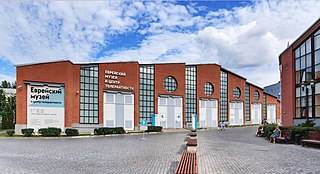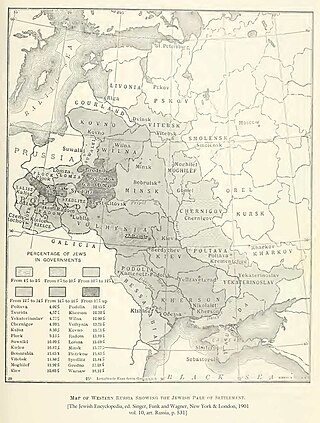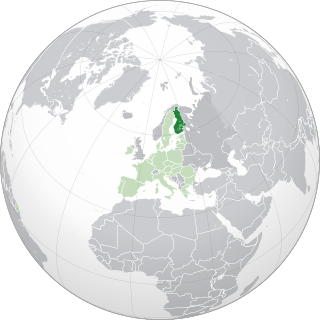
Nicholas I was Emperor of Russia, King of Congress Poland, and Grand Duke of Finland. He was the third son of Paul I and younger brother of his predecessor, Alexander I. Nicholas's reign began with the failed Decembrist revolt. He is mainly remembered in history as a reactionary whose controversial reign was marked by geographical expansion, centralisation of administrative policies, and repression of dissent. Nicholas had a happy marriage that produced a large family; all of their seven children survived childhood.

Boris III, originally Boris Klemens Robert Maria Pius Ludwig Stanislaus Xaver, was the Tsar of the Kingdom of Bulgaria from 1918 until his death in 1943.

The history of the Jews in Russia and areas historically connected with it goes back at least 1,500 years. Jews in Russia have historically constituted a large religious and ethnic diaspora; the Russian Empire at one time hosted the largest population of Jews in the world. Within these territories, the primarily Ashkenazi Jewish communities of many different areas flourished and developed many of modern Judaism's most distinctive theological and cultural traditions, while also facing periods of antisemitic discriminatory policies and persecution, including violent pogroms. Some have described a "renaissance" in the Jewish community inside Russia since the beginning of the 21st century; however, the Russian Jewish population has experienced precipitous decline since the dissolution of the USSR which continues to this day, although it is still among the largest in Europe.

The Pale of Settlement was a western region of the Russian Empire with varying borders that existed from 1791 to 1917 in which permanent residency by Jews was allowed and beyond which Jewish residency, permanent or temporary, was mostly forbidden. Most Jews were still excluded from residency in a number of cities within the Pale as well. A few Jews were allowed to live outside the area, including those with university education, the ennobled, members of the most affluent of the merchant guilds and particular artisans, some military personnel and some services associated with them, including their families, and sometimes their servants. The archaic English term pale is derived from the Latin word palus, a stake, extended to mean the area enclosed by a fence or boundary.

The history of the Jews in the Soviet Union is inextricably linked to much earlier expansionist policies of the Russian Empire conquering and ruling the eastern half of the European continent already before the Bolshevik Revolution of 1917. "For two centuries – wrote Zvi Gitelman – millions of Jews had lived under one entity, the Russian Empire and [its successor state] the USSR. They had now come under the jurisdiction of fifteen states, some of which had never existed and others that had passed out of existence in 1939." Before the revolutions of 1989 which resulted in the end of communist rule in Central and Eastern Europe, a number of these now sovereign countries constituted the component republics of the Soviet Union.

Cantonists were underage sons of conscripts in the Russian Empire. From 1721 on they were educated in special "cantonist schools" for future military service. The cantonist schools and the cantonist system were eventually abolished in 1857, following public and international criticism and the Russian defeat in the Crimean War.

Temporary regulations regarding the Jews were proposed by the minister of internal affairs Nikolay Pavlovich Ignatyev and enacted on 15 May, 1882, by Tsar Alexander III of Russia. Originally, regulations of May 1882 were intended only as temporary measures until a future revision of the laws concerning the Jews but remained in effect for more than thirty years.
Garrison schools in 18th century Russia were military schools that provided the primary education for the children of the military recruits. The institution of the Garrison schools was introduced by the ukase (decree) of Tsar Peter the Great in 1721 primarily for the children of military recruits in the course of Peter's reform of the Russian military. This so-called military revolution transformed the military from an archaic militia-like force to the regular army, which drew upon military recruits called, predominantly from enserfed peasantry, to serve for 25 years, which, given the expected life span of most Russian serfs at the time, essentially meant that they would serve for life. The recruits and their children born after the recruitment were liberated from the serf status, and a network of Garrison schools was created for the children's education. The boys, starting from the age of 7, were taught literacy, elementary math, "artillery and military engineering", but also fine arts and several trade professions, such as shoe-making, sewing, wood- and metal-working, etc.
The history of the Jews in 19th-century Poland covers the period of Jewish-Polish history from the dismemberment of the Polish–Lithuanian Commonwealth, until the beginning of the 20th century.

Horace Günzburg, 2nd Baron Günzburg, was a Russian philanthropist.

The history of Jews in Estonia starts with reports of the presence of individual Jews in what is now Estonia from as early as the 14th century.

The history of the Jews in Finland goes back to the 1700s. The country is home to some 1,800 Jews, of which 1,400 live in the Greater Helsinki area and 200 in Turku. Most Jews in Finland have Finnish or Swedish as their mother tongue, and many speak Yiddish, German, Russian and Hebrew. Jews originally came to Finland as Russian soldiers who stayed in Finland in the 19th century after their military service ended. There are Jewish congregations in Helsinki and Turku with their own synagogues built in 1906 and 1912. The Wiborg Synagogue built 1910–1911 was destroyed in air bombings during the first day of the Winter War in 30 November 1939. Since data collection began in 2008, incidents of antisemitism have been on the rise in Finland. The number of incidents are likely under-reported as Finland does not account for specific forms of hate speech that incite violence or hatred.
Pogroms in the Russian Empire were large-scale, targeted, and repeated anti-Jewish rioting that began in the 19th century. Pogroms began to occur after Imperial Russia, which previously had very few Jews, acquired territories with large Jewish populations from the Polish–Lithuanian Commonwealth and the Ottoman Empire from 1772 to 1815. These territories were designated "the Pale of Settlement" by the Imperial Russian government, within which Jews were reluctantly permitted to live. The Pale of Settlement primarily included the territories of Poland, Ukraine, Belarus, Bessarabia, Lithuania and Crimea. Jews were forbidden from moving to other parts of European Russia, unless they converted from Judaism or obtained a university diploma or first guild merchant status. Migration to the Caucasus, Siberia, the Far East or Central Asia was not restricted.

Conscription in the Russian Empire was introduced by Peter I of Russia. The system was called "conscript obligation".
Antisemitism in the Russian Empire included numerous pogroms and the designation of the Pale of Settlement from which Jews were forbidden to migrate into the interior of Russia, unless they converted to the Russian Orthodox state religion.

Nicholas II or Nikolai II was the last reigning Emperor of Russia, King of Poland and Grand Duke of Finland from 1 November 1894 until his abdication on 15 March 1917. During his reign, Nicholas gave support to the economic and political reforms promoted by his prime ministers, Sergei Witte and Pyotr Stolypin. He advocated modernisation based on foreign loans and close ties with France, but resisted giving the new parliament major roles. Ultimately, progress was undermined by Nicholas's commitment to autocratic rule, strong aristocratic opposition and defeats sustained by the Russian military in the Russo-Japanese War and World War I. By March 1917, public support for Nicholas had collapsed and he was forced to abdicate, thereby ending the Romanov dynasty's 304-year rule of Russia (1613–1917).
Abstinence was a form of draft evasion and a form of hunger strike employed by young men in the Russian Empire's Jewish Pale of Settlement in order to be found unfit for military service by the Imperial authorities.

The history of the Jews in Moscow goes back from the 17th century, the city of Moscow held 175,000 Jews from the Nazis although Moscow did not become an important Jewish center until the late 19th century when more Jews were legally allowed to settle. Prior to the 19th century, Jews had arrived in the city as prisoners of the Russo-Polish war or after 1790, as merchants allowed one month stays. In the late 1800s, the Jewish population boomed, and then dramatically dropped after the 1891 expulsion of Jews from the city. The population grew once again following World War I, and was a Jewish and Zionist cultural center until the end of the revolution, after which it became a Soviet Jewish center for a period of time. The Moscow Jewish community experienced a number of highs and lows under the Soviet Union as Jewish identity became increasingly taboo in the eyes of the government. After the collapse of the Soviet government and the mass migration of a huge portion of Russian Jews from the country, Moscow has still maintained a sizable Jewish population.
This timeline of antisemitism chronicles the acts of antisemitism, hostile actions or discrimination against Jews as a religious or ethnic group, in the 19th century. It includes events in the history of antisemitic thought, actions taken to combat or relieve the effects of antisemitism, and events that affected the prevalence of antisemitism in later years. The history of antisemitism can be traced from ancient times to the present day.

Leo Osnas was a Russian soldier and recipient of the Cross of St. George, the highest award for bravery in the Russian Army. Osnas, a medical student from Wilna, had volunteered for military service and saw action during the First World War. He received his bravery award for saving his regimental colours from being captured by German forces during an action in East Prussia in the early months of the war. The award was made in person by Russian Tsar Nicholas II. In newspaper reports it was stated that Osnas' action had led the Russians to allow Jewish men the right to become officers in the army and navy and for Jewish civilians to receive full citizenship rights. This latter action was not taken.













